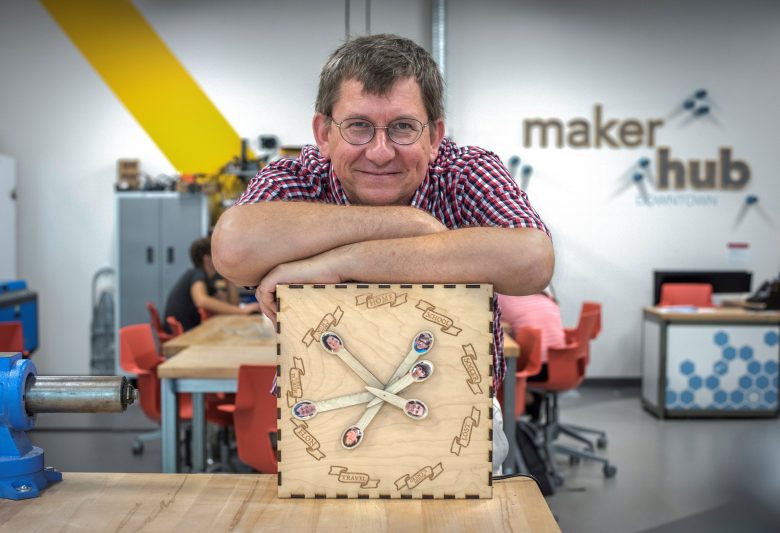Associate Professor of Physics Kyle Altmann used real-life science and technology to recreate a magical artifact from the “Harry Potter” series.

The clock on Associate Professor of Physics Kyle Altmann’s wall is useless at telling the time. But it does show if his wife is at work or traveling, or whether his son is at soccer practice or a friend’s house.
If it sounds like magic, that’s because it is, in a sense. Altmann’s creation is based on the Weasley family’s enchanted clock from the “Harry Potter” series, which displays each family member’s location rather than the time of day. The Weasley clock features nine hands—one for each member of Harry’s best friend’s large household—and in lieu of hours are potential whereabouts such as home, school, lost and mortal peril.
British science fiction writer and futurist Arthur C. Clarke once said, “Any sufficiently advanced technology is indistinguishable from magic.” With his scientific and technological prowess, Altmann decided to transform the clock from fictional wizardry to reality for his own Muggle (aka non-magical) family. “That’s always been something I love about physics,” Altmann says. “We can explain lots of everyday things, but I also love throwing physics at things you wouldn’t expect to be able to explain.” Altmann completed the clock a couple of years ago and gave it to his wife, Katie, as a Mother’s Day gift. “We have a family of four kids, and she loves it when she knows where everybody is, and particularly when we’re all at home together,” Altmann says.
Altmann revisited his Weasley clock during a presentation in May for the Tectonic Plates series, a “science café” featuring discussions on a wide range of STEM topics in a relaxed atmosphere at the Fat Frogg Bar and Grill near Elon’s campus. During the talk, Altmann demonstrated how the magic of Harry Potter can be replicated using real-life science. Take levitation, for example. Altmann crafted a 3D-printed Golden Snitch and put a magnet inside. The Snitch floats in midair below an electromagnet that is controlled by a magnetic field sensor, which detects how far away the Snitch is and changes the electromagnet strength to keep it steady. He demonstrated invisibility and cloaking by simply submerging Pyrex glassware in cooking oil. Light bends or refracts in different ways when it passes through different materials, which affects how the human eye sees the object. Pyrex and cooking oil have the same index of refraction, so the glass seemingly disappears when encased in the oil.
But the centerpiece of the presentation was Altmann’s clock. “I knew I had the background in programming, and I knew I could 3D print some gears,” Altmann says. “It ended up being a good project for trying all sorts of new things in Elon’s Maker Hub.” The space offers tools and allows members of the Elon community to explore ideas and learn new things by doing them. Each member of Altmann’s family uses an app called OwnTracks that runs in the background on their phones and tracks their location. He set up geofences, or virtual boundaries, within the app around the locations his family frequents the most—home, Elon, Katie’s workplace, his son’s best friend’s house, nearby soccer fields—and outfitted the clock with a Raspberry Pi, a small single-board computer. Whenever the Altmanns cross the geofence boundaries, the app sends a message to the server, which prompts the computer to move the appropriate hand on the clock.
When someone leaves a geofenced area, their hand on the clock moves to “travel.” If they don’t enter another geofenced area within six hours, it moves to “lost.” And if they’re “lost” for more than six hours, it moves to the dreaded “mortal peril.” “Katie actually hates that one,” Altmann says. “If the kids are on a field trip or something, she knows where they are. They’re not in mortal peril. But seeing their face next to mortal peril causes her a lot of frustration.”
Altmann says creating the clock was a valuable learning experience that involved a great deal of revision and persistence. “The very first gears I made for the Weasley clock didn’t mesh properly, so I had to redo it a bunch of times,” he says. “The Maker Hub makes that easy to do, to make small revisions and try again.” Instilling those values in students throughout the university is one of Altmann’s goals in his new role as Faculty Fellow for Technology, which he will hold for a three-year term beginning with the 2019–20 academic year. He hopes to help faculty and students across all disciplines find ways to use the Maker Hub to exercise their creativity by designing and building something.
“That’s one of the key ideas behind science education,” Altmann says. “If you know the basic concepts, you have some idea where to begin. You might go down a path that wasn’t correct, but you’ll learn something along the way. There are a lot of parallels between maker education and the kind of persistence and problem solving we want to get out of our students.”


